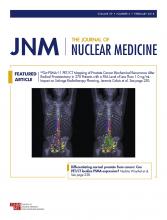Selective tau imaging: Villemagne provides a brief review of the history of tau imaging and associated tracers and the ways in which they are expanding insight into the pathology of Alzheimer disease and other neurodegenerative conditions.
Page 175
PSMA targeting and the urology POV: Donin and Reiter offer an overview of prostate-specific membrane antigen targeting, with a focus on new PET and SPECT imaging tracers, therapeutic applications, and the outlook for future clinical use.
Page 177
Tumor microenvironment imaging: Helfen and colleagues describe the current status of and future outlook for in vivo molecular imaging of tumor immune components to explore cross-talk between tumor cells and the immune system.
Page 183
Responsible radiomics research: Vallières and colleagues present guidelines intended to improve the reporting and statistical qualities and resulting reproducibility of computer-aided diagnosis techniques that characterize tumor phenotypes through extraction of high-dimensional, mineable imaging data.
Page 189
Early PET and GIST management: Farag and colleagues document changes in management based on early evaluation of response on 18F-FDG PET in patients with gastrointestinal stromal tumors treated with neoadjuvant imatinib.
Page 194
18F-4FMFES vs. 18F-FES: Paquette and colleagues compare in a phase II trial the diagnostic potentials of PET imaging with the novel radiotracer 18F-4FMFES and with 18F-FES in patients with estrogen receptor–positive breast cancer.
Page 197
Adding SN biopsy in PCA assessment: Grivas and colleagues study biochemical recurrence after robot-assisted radical prostatectomy and extended pelvic lymph node dissection in prostate cancer patients, stratified by the application of sentinel node biopsy.
Page 204
Positron lymphography in murine melanoma: Lockau and colleagues explore whether metastatic nodes can be distinguished from normal nodes in mice by dynamic 18F-FDG lymphography, followed by resection under Cerenkov imaging guidance.
Page 210
Daratumumab bioconjugate PET/CT in multiple myeloma: Ghai and colleagues evaluate [89Zr]Zr-desferrioxamine-daratumumab, a high-affinity monoclonal antibody targeting CD38, in PET/CT imaging of multiple myeloma tumor models.
Page 216
LAR octreotide and 68Ga-DOTATATE uptake: Ayati and colleagues assess whether 68Ga-DOTATATE uptake on PET in normal tissues, primary tumor, and metastatic lesions before treatment with long-acting repeatable somatostatin analogs differs from that after treatment in individuals with neuroendocrine tumors.
Page 223
PSMA PET: Jadvar and Ballas offer perspective on the potentially transformational applications of prostate-specific membrane antigen imaging and therapy and preview a related article in this issue of JNM.
Page 228
PSMA-11 PET and salvage radiotherapy: Calais and colleagues use 68Ga-PSMA-11 PET/CT to map patterns of early biochemical recurrence after radical prostatectomy in patients with low prostate-specific antigen levels and compare the results with established practice guidelines.
Page 230
PET/CT validation of PSMA expression: Woythal and colleagues evaluate associations between intraprostatic 68Ga-PSMA PET/CT findings and prostate-specific membrane antigen expression on immunohistochemical staining to generate a cutoff value for differentiation between normal prostate and prostate cancer.
Page 238
Molecular RT with radionuclides: Baiu and colleagues test the therapeutic potential of a clinical-grade, 131I-labeled alkyl-phospholipid ether analog as a scaffold for tumor-targeted radiotherapy of pediatric malignancies.
Page 244
123I-MIBG HMR with CZT SPECT: Blaire and colleagues compare the heart-to-mediastinum ratio of 123I-MIBG uptake obtained using a dual-isotope multipinhole CZT camera technique with that using conventional planar imaging in patients with heart failure.
Page 251
Prognostic value of 123I-BMIPP SPECT: Hashimoto and colleagues explore the predictive value of SPECT-derived 123I-BMIPP defect scores in patients who have nonischemic heart failure with preserved ejection fraction.
Page 259
68Ga-pentixafor PET and plaque imaging: Weiberg and colleagues assess the prevalence, pattern, and clinical correlates of arterial wall accumulation of 68Ga-pentixafor, a specific CXC chemokine receptor 4 ligand for PET.
Page 266
PET quantification of MBF: Murthy and experts from the SNMMI and the American Society of Nuclear Cardiology consolidate and update technical considerations for clinical quantification of myocardial blood flow and flow reserve and review the scientific bases for clinical applications.
Page 273
15O-water PET in negative 99mTc-HMPAO SPECT: Acker and colleagues report on 15O-water PET with acetazolamide challenge findings in 18 patients in whom perfusion SPECT with acetazolamide challenge had been interpreted as showing no evidence of impaired cerebrovascular reserve capacity.
Page 294
Tau PET and MR correlations in AD: Nasrallah and colleagues determine whether 18F-flortaucipir PET, which targets tau aggregates, can differentiate nonamnestic from amnestic Alzheimer disease and compare results with MR imaging of gray matter atrophy.
Page 299
Quantification of 18F-DPA-714 PET data: Wimberley and colleagues present and test a compartmental model that accounts for the effect of endothelial translocator protein binding on quantification of 18F-DPA-714 PET scans from a cohort of healthy subjects.
Page 307
11C-HOMADAM PET test–retest: Adhikarla and colleagues measure the reliability of this PET agent with highly specific targeting, fast uptake kinetics, and negligible binding in the cerebellum in assessing serotonin transporter density imaging in healthy controls.
Page 315
68Ga-pentixafor PET/CT in bone infection: Bouter and colleagues determine in patients with suspected infection whether 68Ga-pentixafor, a CXC chemokine receptor 4 ligand,, is suitable for PET/CT imaging in chronic bone infection.
Page 320
LPA1 radiotracer for lung imaging: Gallezot and colleagues develop and evaluate an 11C-labeled radiotracer targeting the lysophosphatidic acid receptor type 1 and report on specific binding and quantification in the lungs of rhesus monkeys.
Page 327
68Ga-NOTA-UBI imaging of infection: Ebenhan and colleagues assess the cytotoxicity and radiation dosimetry of a functionalized antimicrobial peptide in in vitro and primate studies and perform first-in-human evaluations to diagnose infectious processes.
Page 334
Repebodies and EGFR imaging: Pyo and colleagues synthesize and study 3 64Cu-labeled anti–epidermal growth factor receptor repebodies—nonantibody protein scaffolds for tumor targeting that contain leucine-rich repeat modules—in cultured cells and tumor-bearing mice.
Page 340
- © 2018 by the Society of Nuclear Medicine and Molecular Imaging.







